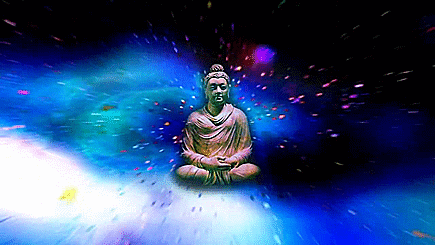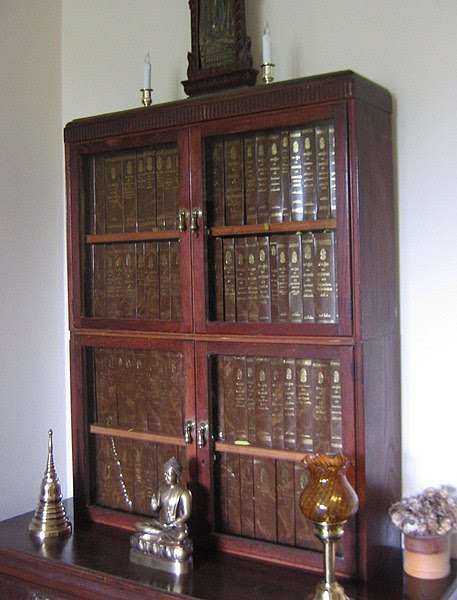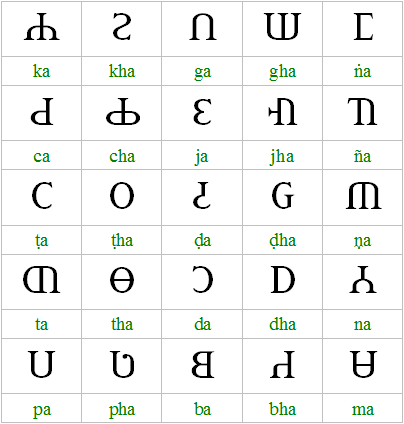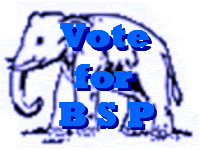|
Welcome to Dhammapada In Tamil
This book is published by BPS, and you can contact them to obtain a hard copy. BPS Tel: 081 2237283 Tel/Fax: 081 2233679  |
LESSON 2922 Tue 5 Mar 2019
Tipitaka - DO GOOD BE MINDFUL is the Essence of the Words of the Awakened One with Awareness
from
Analytic Insight Net - FREE Online Tipiṭaka Law Research & Practice
University
in
112 CLASSICAL LANGUAGES Please Visit: http://sarvajan.ambedkar.org
Brahmajālasuttaṃ
Paribbājakakathā
Brahmajala Sutta
(Discourse on the Net of Perfect Wisdom )
Silakkhandha Vagga, Digha Nikaya, Suttanta Pitaka
29) Classical English,Roman,3Tipiṭaka (Mūla)
https://www.youtube.com/watch?v=_wwAnE65Ous
Tipiṭaka (Mūla)
Vinayapiṭaka
Suttapiṭaka
Dīghanikāya
Sīlakkhandhavaggapāḷi
1. Brahmajālasuttaṃ
Daily Buddhist Theravada Pali Chanting by VenVajiradhamma Thera
Dhammalink
Published on Mar 12, 2013
Daily Buddhist Theravada Pali Chanting by Venerable Vajiradhamma Thera
One of the best Pali Buddhist Chanting. It is a very peaceful, tranquil, pleasant and harmonious chanting.
This Chanting has helped many people to become peace, calm and
tranquil, build mindfulness while listening and/or chant attentively,
re-gain confidence from fear and uncertainty, bring happiness and
positive energy for those who are in sick and those in their last moment
in this very life (as hearing is thought to be the last sense to go in
the dying process). May you get the benefits of this chanting too.
This compilation consists of Recollection of Buddha (Buddhanusati or
Itipiso), Recollection of Dhamma (Dhammanusati), Recollection of Sangaha
(Sanghanusati), Mangala Sutta, Ratana Sutta, Karaniya Metta Sutta,
Khandha Sutta, Bhaddekaratta Gatha, Metta Chant, Accaya Vivarana,
Vandana, Pattanumodana, Devanumodana, Punnanumodana and Patthana.
This compilation is made possible by Venerable Samanera Dhammasiri
getting the permission from Venerable Vajiradhamma Thera to compile and
distribute, and co-edit and proofing. The background image is photo
taken by Venerable Dhammasubho. First compilation completed in 2007 and
further edit was done in 2015. Thanks and Sadhu to all who have assisted
and given me the opportunity to do this compilation especially my
family. May the merits accrue from this compilation share with all. With
Metta, Tissa Ng.
Website: www.dhammalink.com
Copyright © 2007-2015 dhammalink.com
All right reserved. Permission is granted to duplicate without modification for non-commercial purpose.
[You MUST retain this notice for all the duplication, linking or sharing]
Category
Nonprofits & Activism
https://www.youtube.com/watch?v=_R8GQzje4Us
ტიპიტაკა (მურა)
ვინანპაიტაკა
სატუპათია
დიღნაკია
სილაკხანჰავაგაღაფაი
1. Brahmajālasuttaṃ
“კომბლე” 1979 ქართული მულტფილმი (Komble - Georgian Animation)
GiviFilms Studio Kaleidoscope
Published on Apr 9, 2015
ქართული მულტფილმი კომბლე.
რეჟისორი გიორგი (გივი) კასრაძეგიორგი (გივი) კასრაძე
Category
Film & Animation
https://ddl-warez.to/…/8.Tage.S01E01.GERMAN.1080p.HDTV.x26…/
Tipiṭaka (Mūla)
Vinayapiṭaka
Suttapiṭaka
Dīghanikāya
Sīlakkhandhavaggapāḷi
1. Brahmajālasuttaṃ
General: HDTV | 43m39s
Video: 1920×960 | 4924kb/s | CRF 19 | x264 r2901
Audio: DE AC3 5.1 384 kb/s
Es bleiben noch acht Tage, bis ein Asteroid, der auf die Erde zurast,
mitten in Europa einschlagen wird. Hier gibt es keine Überlebenschancen
mehr, ganz Europa ist auf der Flucht. Aus der Sicht einer Berliner
Familie erzählt die Serie vom Überlebenskampf der Menschen im Angesicht
der herannahenden Katastrophe.
https://www.gettyimages.in/photos/classical-greek…
Tipiṭaka (Mūla)
Vinayapiṭaka
Suttapiṭaka
Dīghanikāya
Sīlakkhandhavaggapāḷi
1. Brahmajālasuttaṃ






Pali Alphabet and Pronunciation
Learn Pali Grammar & Language - Basic Declension
- Nominative & Accusative - Pali noun cases & declension
Pāli (पालि)
Pāli is the language of the scriptures of Theravada Buddhism,
(the Pāli Canon or the Tipitaka in Pāli), which
were written in Sri Lanka during the 1st century BC. Pāli has been
written in a variety of scripts, including Brahmi,
Devanāgarī and other Indic scripts,
and also using a version of the Latin alphabet devised by T. W. Rhys Davids of
the Pāli Text Society.
The name Pāli means “line” or “(canonical) text”, and probably comes
from the commentarial traditions, wherein the “Pāli” (in the sense of
the line of original text quoted) was distinguished from the commentary or
the vernacular following after it on the manuscript page. There are a number
of ways to spell the name of the language: Pali, Pāli, Paḷi,
Pāḷi, all four of which are found in textbooks.
Today Pāli is studied mainly by those who wish to read the original
Buddhist scriptures, and is frequently chanted in rituals. There are non-religious
text in Pāli including historical and medical texts. The main areas where
Pāli is studied are Myanmar, Sri Lanka, Thailand, Laos and Cambodia.
Devanāgarī alphabet for Pāli
Pali Alphabet and Pronunciation
Learn Pali Grammar & Language - Basic Declension
- Nominative & Accusative - Pali noun cases & declension
Pāli (पालि)
Pāli is the language of the scriptures of Theravada Buddhism,
(the Pāli Canon or the Tipitaka in Pāli), which
were written in Sri Lanka during the 1st century BC. Pāli has been
written in a variety of scripts, including Brahmi,
Devanāgarī and other Indic scripts,
and also using a version of the Latin alphabet devised by T. W. Rhys Davids of
the Pāli Text Society.
The name Pāli means “line” or “(canonical) text”, and probably comes
from the commentarial traditions, wherein the “Pāli” (in the sense of
the line of original text quoted) was distinguished from the commentary or
the vernacular following after it on the manuscript page. There are a number
of ways to spell the name of the language: Pali, Pāli, Paḷi,
Pāḷi, all four of which are found in textbooks.
Today Pāli is studied mainly by those who wish to read the original
Buddhist scriptures, and is frequently chanted in rituals. There are non-religious
text in Pāli including historical and medical texts. The main areas where
Pāli is studied are Myanmar, Sri Lanka, Thailand, Laos and Cambodia.
Devanāgarī alphabet for Pāli

Download an alphabet chart for Pali
Sample text in Pāli (Romanized script)
Manopubbangamā dhammā, manosetthā manomayā;
Manasā ce padutthena, bhāsati vā karoti vā,
Tato nam dukkhamanveti, cakkam’va vahato padam.
Translation
Mind precedes all mental states. Mind is their chief; they are all
mind-wrought. If with an impure mind a person speaks or acts suffering
follows him like the wheel that follows the foot of the ox.
(Translated by Acharya Buddharakkhita)
Sample text in Pāli (Romanized script)
Manasā ce padutthena, bhāsati vā karoti vā,
Tato nam dukkhamanveti, cakkam’va vahato padam.
Translation
Mind precedes all mental states. Mind is their chief; they are all
mind-wrought. If with an impure mind a person speaks or acts suffering
follows him like the wheel that follows the foot of the ox.
(Translated by Acharya Buddharakkhita)
Sample text in Pāli (Romanized script)
Appam pi ce saṃhitaṃ bhāsamāno dhammassa
hoti anudhammacārī, rāgañ ca dosañ
ca pahāya mohaṃ sammāppajāno suvimuttacitto,
anupādiyāno idha vā huraṃ vā sa
bhāgavā sāmaññassa hoti.
Translation
Even if he recites a little of scriptures, but lives in truth according
to the Dharma, having abandoned lust, hatred and delusion, has the right
knowledge, with a well emancipated mind, is not attached to anything, either
in this world, nor in the other one, he shares the [blessings of] monkshood.
(Source: of Digital Library & Museum of Buddhist studies)
Sample text in Pāli (Romanized script)
Appam pi ce saṃhitaṃ bhāsamāno dhammassa
hoti anudhammacārī, rāgañ ca dosañ
ca pahāya mohaṃ sammāppajāno suvimuttacitto,
anupādiyāno idha vā huraṃ vā sa
bhāgavā sāmaññassa hoti.
Translation
to the Dharma, having abandoned lust, hatred and delusion, has the right
knowledge, with a well emancipated mind, is not attached to anything, either
in this world, nor in the other one, he shares the [blessings of] monkshood.
(Source: of Digital Library & Museum of Buddhist studies)
Hear a recording of this text by Oscar A. Solari
The information on this page comes mainly from Oscar A. Solari.
Links
Information about the Pāli language
http://en.wikipedia.org/wiki/Pali_language
Pāli language sources and resources
http://orunla.org/tm/pali/
A Guide to Learning the Pāli Language
http://www.accesstoinsight.org/lib/authors/bullitt/learningpali.html
Tipitaka Network - includes information about the Pāli language and some lessons
http://www.tipitaka.net/pali/
Pāli Text Society
http://www.palitext.com
|
www.palitext.com
The Web Site of The Palitext Society, U.K
|
Pāli-English dictionary
http://dsal.uchicago.edu/dictionaries/pali/
Languages written with the Devanāgarī alphabet
Awadhi,
Bodo,
Bhojpuri,
Hindi,
Kashmiri,
Konkani,
Kurukh,
Magahi,
Maithili,
Marathi,
Marwari,
Mundari,
Nepal Bhasa / Newari,
Nepali,
Pali,
Rajasthani,
Sanskrit,
Saraiki,
Shina,
Sindhi,
Sunuwar,
Sylheti
If you like this site and find it useful, you can support it by making a donation, or by contributing in other ways. Omniglot is how I make my living.
http://skyknowledge.com/akkharamuni.htm
Akkhara Muni
Ian James
© January 2010, November 2011

Akkhara Muni
Ian James
© January 2010, November 2011

This is an experimental script for Pali, the ecclesiastical language of Buddhism.
Pali is normally written in the Sinhala, Khmer, Burmese, Devanagari,
Lao or Thai scripts, or with the Latin alphabet using diacritics.
This script has a Classical serif font style,
with shapes based on those of ancient Brahmi and Pallava,
which were the ancestors of the Indic scripts just mentioned.
It aims at a unified, linear effect, without complicated
vowel placement or diacritics. The name means Letters of the Sage.
Consonants
Most letters are quite easily recognizable from their counterparts in other Indic scripts.
As with almost all Indic scripts, and different from Ariyaka,
consonants have an inherent short /a/ if no vowel letter is written.

This is an experimental script for Pali, the ecclesiastical language of Buddhism.
Pali is normally written in the Sinhala, Khmer, Burmese, Devanagari,
Lao or Thai scripts, or with the Latin alphabet using diacritics.
This script has a Classical serif font style,
with shapes based on those of ancient Brahmi and Pallava,
which were the ancestors of the Indic scripts just mentioned.
It aims at a unified, linear effect, without complicated
vowel placement or diacritics. The name means Letters of the Sage.
Consonants
Most letters are quite easily recognizable from their counterparts in other Indic scripts.
As with almost all Indic scripts, and different from Ariyaka,
consonants have an inherent short /a/ if no vowel letter is written.


The glottal plosive acts as a prefix for initial vowels, as is found in many Indic scripts.
The two extra /s/ glyphs are for Sanskrit words. The dotted /m/ suffix is a vowel nasalizer,
being a common Pali morpheme. It may be noted the retroflex laterals are not encoded;
they are considered allophones of the retroflex plosives, emerging in speech when between vowels.
Vowels
The written vowels follow their consonants in all cases,
in a linear, single-channel manner; this is unlike most Indic scripts,
whose vowels end up all over the place. The /ai/ and /au/ glyphs are for Sanskrit words.
A “no vowel” mark may be used to cancel the inherent short /a/,
as is required for consonants which close a syllable.

The glottal plosive acts as a prefix for initial vowels, as is found in many Indic scripts.
The two extra /s/ glyphs are for Sanskrit words. The dotted /m/ suffix is a vowel nasalizer,
being a common Pali morpheme. It may be noted the retroflex laterals are not encoded;
they are considered allophones of the retroflex plosives, emerging in speech when between vowels.
Vowels
The written vowels follow their consonants in all cases,
in a linear, single-channel manner; this is unlike most Indic scripts,
whose vowels end up all over the place. The /ai/ and /au/ glyphs are for Sanskrit words.
A “no vowel” mark may be used to cancel the inherent short /a/,
as is required for consonants which close a syllable.

Punctuation etc
The “no vowel between” mark is for non-final, cluster or sandhi situations
where the consonants run together. Where a consonant is doubled, a colon-shape is used in place of the
second component. Note that where an aspirated consonant is doubled, an unaspirated form arises as the first
component of the gemination; in Akkhara Muni, only the aspirated consonant is written, and any loss
of aspiration due to doubling is ignored in writing.

Please note that Akkhara Muni seeks to capture the phonetics of the language,
and not duplicate existing systems of spelling. Even so, some further work may be required to
deal with all phonological conditions adequately, and/or simplify common morphological situations.
Examples
These are based on my own poor reading of the Romanized Pali, and so may not perfectly reflect the
classical pronunciation. Ideally, we will want to read and hear something close to what the Buddha
himself might have said.
1. This is the first verse of the Dhammapada.


“Mind precedes all mental states, mind is their chief, they are all mind-wrought.
If a person speaks or acts with an impure mind,
Suffering follows him like the wheel follows the foot of the ox.”
2. This is the 154th verse of the Dhammapada.

“Oh house-builder! You are seen, you shall build no house (for me) again.
All your rafters are broken, your roof-tree is destroyed.
My mind has reached the unconditioned; the end of craving has been attained.”
Punctuation etc
The “no vowel between” mark is for non-final, cluster or sandhi situations
where the consonants run together. Where a consonant is doubled, a colon-shape is used in place of the
second component. Note that where an aspirated consonant is doubled, an unaspirated form arises as the first
component of the gemination; in Akkhara Muni, only the aspirated consonant is written, and any loss
of aspiration due to doubling is ignored in writing.

Please note that Akkhara Muni seeks to capture the phonetics of the language,
and not duplicate existing systems of spelling. Even so, some further work may be required to
deal with all phonological conditions adequately, and/or simplify common morphological situations.
Examples
These are based on my own poor reading of the Romanized Pali, and so may not perfectly reflect the
classical pronunciation. Ideally, we will want to read and hear something close to what the Buddha
himself might have said.
1. This is the first verse of the Dhammapada.


“Mind precedes all mental states, mind is their chief, they are all mind-wrought.
If a person speaks or acts with an impure mind,
Suffering follows him like the wheel follows the foot of the ox.”
2. This is the 154th verse of the Dhammapada.

Please note that Akkhara Muni seeks to capture the phonetics of the language,
and not duplicate existing systems of spelling. Even so, some further work may be required to
deal with all phonological conditions adequately, and/or simplify common morphological situations.
Examples
These are based on my own poor reading of the Romanized Pali, and so may not perfectly reflect the
classical pronunciation. Ideally, we will want to read and hear something close to what the Buddha
himself might have said.
1. This is the first verse of the Dhammapada.

“Mind precedes all mental states, mind is their chief, they are all mind-wrought.
If a person speaks or acts with an impure mind,
Suffering follows him like the wheel follows the foot of the ox.”
2. This is the 154th verse of the Dhammapada.
“Oh house-builder! You are seen, you shall build no house (for me) again.
All your rafters are broken, your roof-tree is destroyed.
My mind has reached the unconditioned; the end of craving has been attained.”
“Oh house-builder! You are seen, you shall build no house (for me) again.
All your rafters are broken, your roof-tree is destroyed.
My mind has reached the unconditioned; the end of craving has been attained.”

Introduction By: Ven. Bikku Bodhi
A version of this page can also be found on
Omniglot.
See also:
Thai and Lao for writing Pali, and
the Ariyaka script created by King Rama IV of Siam.
37) Classical Georgian-კლასიკური ქართული,
03)Magadhi Prakrit,
05) Classical Pali,
06) Classical Devanagari,Classical Hindi-Devanagari- शास्त्रीय हिंदी,
07) Classical Cyrillic
08) Classical Afrikaans– Klassieke Afrikaans
09) Classical Albanian-Shqiptare klasike,
10) Classical Amharic-አንጋፋዊ አማርኛ,
11) Classical Arabic-اللغة العربية الفصحى
12) Classical Armenian-դասական հայերեն,
13) Classical Azerbaijani- Klassik Azərbaycan,
14) Classical Basque- Euskal klasikoa,
15) Classical Belarusian-Класічная беларуская,
16) Classical Bengali-ক্লাসিক্যাল বাংলা,
17) Classical Bosnian-Klasični bosanski,
18) Classical Bulgaria- Класически българск,
19) Classical Catalan-Català clàssic
20) Classical Cebuano-Klase sa Sugbo,
21) Classical Chichewa-Chikale cha Chichewa,
22) Classical Chinese (Simplified)-古典中文(简体),
23) Classical Chinese (Traditional)-古典中文(繁體),
24) Classical Corsican-Corsa Corsicana,
25) Classical Croatian-Klasična hrvatska,
26) Classical Czech-Klasická čeština,
27) Classical Danish-Klassisk dansk,Klassisk dansk,
28) Classical Dutch- Klassiek Nederlands,
29) Classical English,Roman
30) Classical Esperanto-Klasika Esperanto,
31) Classical Estonian- klassikaline eesti keel,
32) Classical Filipino,
33) Classical Finnish- Klassinen suomalainen,
34) Classical French- Français classique,
35) Classical Frisian- Klassike Frysk,
36) Classical Galician-Clásico galego,
37) Classical Georgian-კლასიკური ქართული,
38) Classical German- Klassisches Deutsch,
39) Classical Greek-Κλασσικά Ελληνικά,
40) Classical Gujarati-ક્લાસિકલ ગુજરાતી,
41) Classical Haitian Creole-Klasik kreyòl,
42) Classical Hausa-Hausa Hausa,
43) Classical Hawaiian-Hawaiian Hawaiian,
44) Classical Hebrew- עברית קלאסית
45) Classical Hmong- Lus Hmoob,
46) Classical Hungarian-Klasszikus magyar,
47) Classical Icelandic-Klassísk íslensku,
48) Classical Igbo,
49) Classical Indonesian-Bahasa Indonesia Klasik,
50) Classical Irish-Indinéisis Clasaiceach,
51) Classical Italian-Italiano classico,
52) Classical Japanese-古典的なイタリア語,
53) Classical Javanese-Klasik Jawa,
54) Classical Kannada- ಶಾಸ್ತ್ರೀಯ ಕನ್ನಡ,
55) Classical Kazakh-Классикалық қазақ,
56) Classical Khmer- ខ្មែរបុរាណ,
57) Classical Korean-고전 한국어,
58) Classical Kurdish (Kurmanji)-Kurdî (Kurmancî),
59) Classical Kyrgyz-Классикалык Кыргыз,
60) Classical Lao-ຄລາສສິກລາວ,
61) Classical Latin-LXII) Classical Latin,
62) Classical Latvian-Klasiskā latviešu valoda,
63) Classical Lithuanian-Klasikinė lietuvių kalba,
64) Classical Luxembourgish-Klassesch Lëtzebuergesch,
65) Classical Macedonian-Класичен македонски,
66) Classical Malagasy,
67) Classical Malay-Melayu Klasik,
68) Classical Malayalam-ക്ലാസിക്കൽ മലയാളം,
69) Classical Maltese-Klassiku Malti,
70) Classical Maori-Maori Maori,
71) Classical Marathi-क्लासिकल माओरी,
72) Classical Mongolian-Сонгодог Монгол,
73) Classical Myanmar (Burmese)-Classical မြန်မာ (ဗမာ),
74) Classical Nepali-शास्त्रीय म्यांमार (बर्मा),
75) Classical Norwegian-Klassisk norsk,
76) Classical Pashto- ټولګی پښتو
77) Classical Persian-کلاسیک فارسی
78) Classical Polish-Język klasyczny polski,
79) Classical Portuguese-Português Clássico,
80) Classical Punjabi-ਕਲਾਸੀਕਲ ਪੰਜਾਬੀ,
81) Classical Romanian-Clasic românesc,
82) Classical Russian-Классический русский,
83) Classical Samoan-Samoan Samoa,
84) Classical Scots Gaelic-Gàidhlig Albannach Clasaigeach,
85) Classical Serbian-Класични српски,
86) Classical Sesotho-Seserbia ea boholo-holo,
87) Classical Shona-Shona Shona,
88) Classical Sindhi,
89) Classical Sinhala-සම්භාව්ය සිංහල,
90) Classical Slovak-Klasický slovenský,
91) Classical Slovenian-Klasična slovenska,
92) Classical Somali-Soomaali qowmiyadeed,
93) Classical Spanish-Español clásico,
94) Classical Sundanese-Sunda Klasik,
95) Classical Swahili,
96) Classical Swedish-Klassisk svensk,
97) Classical Tajik-тоҷикӣ классикӣ,
98) Classical Tamil-பாரம்பரிய இசைத்தமிழ் செம்மொழி,
99) Classical Telugu- క్లాసికల్ తెలుగు,
100) Classical Thai-ภาษาไทยคลาสสิก,
101) Classical Turkish-Klasik Türk,
102) Classical Ukrainian-Класичний український,
103) Classical Urdu- کلاسیکی اردو
104) Classical Uzbek-Klassik o’zbek,
105) Classical Vietnamese-Tiếng Việt cổ điển,
106) Classical Welsh-Cymraeg Clasurol,
107) Classical Xhosa-IsiXhosa zesiXhosa,
108) Classical Yiddish- קלאסישע ייִדיש
110) Classical Zulu-I-Classical Zulu
https://in.news.yahoo.com/robot-monk-blends-science-buddhism-chinese-temple-022046666.html
Robot monk blends science and Buddhism at Chinese templeBy Joseph CampbellReuters23 April 2016
https://www.rt.com/viral/340638-buddha-robot-longquan-beijing/
Buddha-bot: Chinese temple enlists mini monk robot to boost teachings (VIDEO)

https://in.news.yahoo.com/robot-monk-blends-science-buddhism-chinese-temple-022046666.html
Robot monk blends science and Buddhism at Chinese templeBy Joseph CampbellReuters23 April 2016
https://www.rt.com/viral/340638-buddha-robot-longquan-beijing/
Buddha-bot: Chinese temple enlists mini monk robot to boost teachings (VIDEO)

Voice of All Awakened Aboriginal Societies (VoAAAS)
http://www.picturesanimations.com/e/elephant/14anim.gif

http://www.ambedkar.org/gifimages/voteforBSP.gif

Maha Sathipattana Suthraya - මහා සතිපට්ඨාන සුත්රය -
LESSONS
https://www.youtube.com/watch?
for
Maha-parinibbana Sutta — Last Days of the Buddha
The Great Discourse on the Total Unbinding
This
wide-ranging sutta, the longest one in the Pali canon, describes the
events leading up to, during, and immediately following the death and
final release (parinibbana) of the Buddha. This colorful narrative
contains a wealth of Dhamma teachings, including the Buddha’s final
instructions that defined how Buddhism would be lived and practiced long
after the Buddha’s death — even to this day. But this sutta also
depicts, in simple language, the poignant human drama that unfolds among
the Buddha’s many devoted followers around the time of the death of
their beloved teacher.
https://www.youtube.com/watch?
for
Mahāsatipaṭṭhānasuttaṃ (Pali) - 2 Kāyānupassanā ānāpānapabbaṃ
http://www.buddha-vacana.org/
Use
http://www.translate.google.
Rector
JC
an expert who identifies experts influenced by Expert and Infulencer Sashikanth Chandrasekharan
of
Awaken One With Awareness Mind
(A1wAM)+ ioT (insight-net of Things) - the art of Giving, taking and Living to attain Eternal Bliss
as Final Goal through Electronic Visual Communication Course on
Political Science -Techno-Politico-Socio Transformation and Economic
Emancipation Movement (TPSTEEM).
Struggle hard to see that all fraud EVMs are replaced by paper ballots by
Start
using Internet of things by creating Websites, blogs. Make the best use
of facebook, twitter etc., to propagate TPSTEEM thru FOA1TRPUVF.
Practice
Insight Meditation in all postures of the body - Sitting, standing,
lying, walking, jogging, cycling, swimming, martial arts etc., for
health mind in a healthy body.
from
Analytic Insight Net - Online Tipiṭaka Law Research & Practice University
in
112 CLASSICAL LANGUAGES
Online Tipiṭaka Law Research & Practice University
in
112 CLASSICAL LANGUAGES
Paṭisambhidā Jāla-Abaddha Paripanti Tipiṭaka nīti Anvesanā ca
Paricaya Nikhilavijjālaya ca ñātibhūta Pavatti Nissāya
http://sarvajan.ambedkar.org anto 112 Seṭṭhaganthāyatta Bhās
through
 http://sarvajan.ambedkar.org
http://sarvajan.ambedkar.org

buddhasaid2us@gmail.com
jchandra1942@icloud.com
sarvajanow@yahoo.co.in
Transformation and Economic Emancipation Movement followed by millions
of people all over the world in 112 Classical languages.
Rendering exact translation as a lesson of this
University in one’s mother tongue to this Google Translation and
propagation entitles to become a Stream Enterer (Sottapanna) and to attain Eternal Bliss as a Final Goal
|
SARVA SAMAJ MEDIA
for
WELFARE, HAPPINESS AND PEACE
of
ALL SOCIETIES
From
MEDIA PRABANDHAK
JC  MEDIA
PRABANDHAK
|
|
|


















